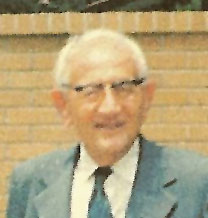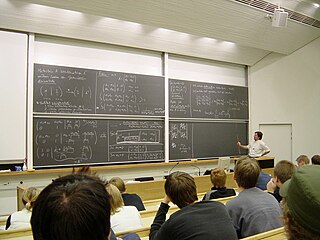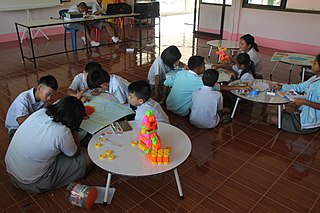
George Pólya was a Hungarian mathematician. He was a professor of mathematics from 1914 to 1940 at ETH Zürich and from 1940 to 1953 at Stanford University. He made fundamental contributions to combinatorics, number theory, numerical analysis and probability theory. He is also noted for his work in heuristics and mathematics education. He has been described as one of The Martians, an informal category which included one of his most famous students at ETH Zurich, John von Neumann.
A teaching method is a set of principles and methods used by teachers to enable student learning. These strategies are determined partly on subject matter to be taught and partly by the nature of the learner. For a particular teaching method to be appropriate and efficient it has take into account the learner, the nature of the subject matter, and the type of learning it is supposed to bring about.

How to Solve It (1945) is a small volume by mathematician George Pólya describing methods of problem solving.

In contemporary education, mathematics education—known in Europe as the didactics or pedagogy of mathematics—is the practice of teaching, learning, and carrying out scholarly research into the transfer of mathematical knowledge.
Principles and Standards for School Mathematics (PSSM) are guidelines produced by the National Council of Teachers of Mathematics (NCTM) in 2000, setting forth recommendations for mathematics educators. They form a national vision for preschool through twelfth grade mathematics education in the US and Canada. It is the primary model for standards-based mathematics.
Founded in 1920, The National Council of Teachers of Mathematics (NCTM) is a professional organization for schoolteachers of mathematics in the United States. One of its goals is to improve the standards of mathematics in education. NCTM holds annual national and regional conferences for teachers and publishes five journals.

Project-based learning (PBL) is a student-centered pedagogy that involves a dynamic classroom approach in which it is believed that students acquire a deeper knowledge through active exploration of real-world challenges and problems. Students learn about a subject by working for an extended period of time to investigate and respond to a complex question, challenge, or problem. It is a style of active learning and inquiry-based learning. PBL contrasts with paper-based, rote memorization, or teacher-led instruction that presents established facts or portrays a smooth path to knowledge by instead posing questions, problems, or scenarios.
Ann Lesley Brown (1943–1999) was an educational psychologist who developed methods for teaching children to be better learners. Her interest in the human memory brought Brown to focus on active memory strategies that would help enhance human memory and developmental differences in memory tasks. Her realization that children's learning difficulties often stem from an inability to use metacognitive strategies such as summarizing led to profound advances in educational psychology theory and teaching practices.
Formative assessment, formative evaluation, formative feedback, or assessment for learning, including diagnostic testing, is a range of formal and informal assessment procedures conducted by teachers during the learning process in order to modify teaching and learning activities to improve student attainment. The goal of a formative assessment is to monitor student learning to provide ongoing feedback that can help students identify their strengths and weaknesses and target areas that need work. It also helps faculty recognize where students are struggling and address problems immediately. It typically involves qualitative feedback for both student and teacher that focuses on the details of content and performance. It is commonly contrasted with summative assessment, which seeks to monitor educational outcomes, often for purposes of external accountability.

Marcia C. Linn is a professor of development and cognition. Linn, specializes in education in mathematics, science, and technology in the Graduate School of Education at the University of California, Berkeley. Since 1970, Linn has made contributions to the understanding of the use of computers and technology to support learning and teaching in mathematics and science.
Professor Tom Lowrie was appointed a Centenary Professor at the University of Canberra, Australia, in 2014. He has an established international research profile in the discipline area of STEM education and mathematics education.
In U.S. education, deeper learning is a set of student educational outcomes including acquisition of robust core academic content, higher-order thinking skills, and learning dispositions. Deeper learning is based on the premise that the nature of work, civic, and everyday life is changing and therefore increasingly requires that formal education provides young people with mastery of skills like analytic reasoning, complex problem solving, and teamwork.
James G. Greeno was an American experimental psychologist and learning scientist whose research focused on learning and problem solving with conceptual understanding, using scientific concepts and methods of association theory, computational cognitive modeling, and discourse analysis.

Michael J. Hannafin was Professor of Instructional Technology and Director of Learning and Performance Support Laboratory at the University of Georgia. He obtained a Ph.D. in Educational Technology from the Arizona State University. Along with Kyle Peck, he developed the field of Computer Aided Instruction as distinguished from Computer Based Instruction. He received the AERA SIG- IT Best Paper Award in 2007.
Cathy Kessel is a U.S. researcher in mathematics education and consultant, past-president of Association for Women in Mathematics, winner of the Association for Women in Mathematics Louise Hay Award, and a blogger on Mathematics and Education. She served as an editor for Illustrative Mathematics from the end of 2015 through July 15, 2017.
PR1ME Mathematics teaching programme (PR1ME) is created for the primary or elementary grades and was first introduced in 2014 by Scholastic. It is adopted by schools in multiple countries such as Philippines, Australia, New Zealand and Mexico. PR1ME is a programme based on the Mathematics teaching and learning practices of Singapore, Hong Kong and Republic of Korea, which have consistently performed strongly in international mathematics studies such as the Trends in International Mathematics and Science Study (TIMSS) and Organisation for Economic Co-operation and Development's Programme for International Student Assessment (PISA). This programme was developed in collaboration with the Ministry of Education (MOE), Singapore and is adapted from the Primary Mathematics Project developed by MOE.
Lynn Fuchs is an educational psychologist known for research on instructional practice and assessment, reading disabilities, and mathematics disabilities. She is the Dunn Family Chair in Psychoeducational Assessment in the Department of Special Education at Vanderbilt University.
Michelene (Micki) T. H. Chi is a cognitive and learning scientist known for her work on the development of expertise, benefits of self-explanations, and active learning in the classroom. Chi is the Regents Professor, Dorothy Bray Endowed Professor of Science and Teaching at Arizona State University, where she directs the Learning and Cognition Lab.
Laura Mary O'Dwyer is a professor of Measurement, Evaluation, and Statistics at Boston College known for her work on examining the impact of technology in education, especially science education, and for quantifying outcomes for K-12 student success.
Jeremy Kilpatrick was an American mathematics educator. He received the Felix Klein Medal for 2007 from ICMI. He graduated from Chaffey two-year college in California (1954), then he went to the University of California at Berkeley to earn an A.B degree (1956) in mathematics and after an M.A degree (1960) in education. He received his M.S. in mathematics in 1962 and his PhD degree in mathematics education in 1967, both from Stanford University, where he was also a research assistant in the SMSG (1962-1967). His dissertation was supervised by Edward Begle with George Pólya and Lee Conbrach in the doctoral committee, and addressed eight graders’ problem-solving heuristics. From 1967 to 1975 he taught from as an assistant and later as an associate professor at Teachers College, Columbia University, in New York. In 1975, he moved to the University of Georgia, where he was a professor of mathematics education.






